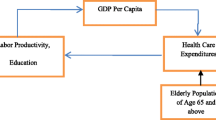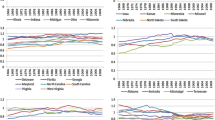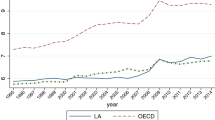Abstract
Uneven patterns of health care expenditure are a prominent feature of late capitalist society. Across Europe, spearheaded by European Union (EU) economic integration, there continues to be debate concerning health care expenditure and, more specifically, to what extent there has been an apparent convergence or divergence. The extant literature is contradictory, inconclusive and potentially misleading, characterised as a ‘mixed bag’. Therefore, as a means of resolving some of these tensions, this paper tests the hypothesis that health care expenditure per capita has converged. Departing from a conceptual review of key factors influencing health care expenditure, this paper applies a non linear time series test to longitudinal data for 14 EU countries for the period 1970–2008. This paper fills a notable research gap by better accounting for the existence of nonlinearity in the growth dynamics of health care expenditure by utilising the nonlinear panel unit root test. Using different reference countries, we cannot reject the null hypothesis of unit root-evidence against the notion of convergence. This generates some notable policy implications and raises issues for those researching this topic.


Similar content being viewed by others
Notes
For a more recent study, see Batalgi and Moscone (2010).
For a comparative study of the EU member states’ health care system comparison, see Jakubowski and Busse (1998).
In the first draft, \( \bar{g}_{t} \) was the average of all 14 EU countries. We received comments from anonymous reviewers who suggested excluding the country under consideration. The results remain the same.
Im et al. (2003) contend that the LM-bar statistic requires less strict convergence criteria \( \left(\frac{{N_{1} }}{N} \to k\right) \) than that of Levin and Lih (1993).
For a more general case where the errors are serially correlated, Eq. (9) is extended to: \( \Delta y_{i,t} = a_{i} + \delta y_{i,t - 1}^{3} + \sum\limits_{h = 1}^{h - 1} \vartheta_{ih} \Delta y_{i,t - h} + \gamma_{i} f_{t} + \varepsilon_{i,t}. \)
The trend is assumed to have a constant and linear trend.
Our analysis is ‘heuristic’ since the minimum sample size for BDS statistic to have reasonable performance is 500.
Due to small sample size, the BDS test is limited to ten countries.
The choice of benchmark countries is dictated by data availability. The panel of 14 EU countries is unbalanced.
References
Abel-Smith, B., Figueras, J., Holland, W., McKee, M., & Mossialos, E. (1995). Choices in health policy: an agenda for the European Union. European Political Economy Series: Dartmouth.
Abiad, A., Leigh, D., & Mody, A. (2007). International finance and income convergence: Europe is different, IMF Working Paper, WP/07/64.
Aslan, A. (2008). Convergence of per capita health care expenditures in OECD Countries. MPRA Paper 10592, University Library of Munich, Germany.
Bai, J., & Ng, S. (2004). A panick attack on unit roots and cointegration. Econometrica, 72, 1127–1177.
Baltagi, B. H., & Kao, C. (2000) Nonstationary panels, cointegration in panels and dynamic panels: a survey. In: B. H. Baltagi (Ed.), Nonstationary panels, panel cointegration, and dynamic panels, advances in econometrics, vol. 5 (pp. 7–51).
Ben-David, D. (1996). Trade and convergence among countries. Journal of International Economics, 40, 279–298.
Beyart, A., & Camacho, M. (2008). TAR panel unit root tests and real convergence. Review of Development Economics, 12(3), 661–681.
Bilgel, F., & Tran, K. C. (2013). The determinants of Canadian provincial health expenditures: evidence from a dynamic panel. Applied Economics, 45(2), 201–212.
Breitung, J. (2000). The local power of some unit root tests for panel data. In B. H. Baltagi (Ed.), Nonstationary panels, panel cointegration and dynamic panels (pp. 161–177). Amsterdam: Elsevier.
Brock, W. A., Dechert, W. D., & Scheinkman, J. A. (1987). A test for independence based on the correlation dimension. Econometric Reviews, 15, 197–235.
Cerrato, M., Peretti, C. D., & Sarantis, N. (2011). A nonlinear panel unit root test under cross section dependence. Working paper, Department of Economics, University of Glasgow.
Chang, Y. (2004). Bootstrap unit root tests in panels with cross-sectional dependency. Journal of Econometrics, 120, 263–293.
Choi, I. (2001). Unit root tests for panel data. Journal of International Money and Finance, 20, 249–272.
Choi, I., & Chue, T. K. (2007). Subsampling hypothesis tests for nonstationary panels with applications to exchange rates and stock prices. Journal of Applied Econometrics, 22(2), 233–264.
Chong, T. L., Hinichb, M. J., Liewc, K. S., & Lim, K. P. (2008). Time series test of nonlinear convergence and transitional dynamics. Economics Letters, 100(3), 337–339.
Chou, W. L. (2007). Explaining China’s regional health expenditures using LM-type unit root tests. Journal of Health Economics, 26, 682–698.
Cucic, S. (2000). European Union health policy and its implications for national convergence. International J Qual Health Care, 12, 217–225.
Di Matteo, L., & Di Matteo, R. (1998). Evidence on the determinants of Canadian provincialgovernment health expenditures:1965–1991. Journal of Health Economics, 17, 211–228.
Dogan, H., & Saracoglu, B. (2007). International finance and income convergence: Europe is different? International Research Journal of Finance and Economics, 12, 160–164.
Harris, D., Leybourne, S., & McCabe, B. (2004). Panel stationarity tests for puchasing power parity with cross-sectional dependence, manuscript, University of Nottingham, August.
Herwartz, H., & Theilen, B. (2003). The determinants of health care expenditure: testing pooling restrictions in small samples. Health Economics, 12, 113–124.
Hitiris, T., & Nixon, J. (2001). Convergence in health care expenditure in the EU countries. Applied Economics Letters, 8(4), 223–228.
Hitiris, T., & Posnett, J. (1992). The determinants and effects of health expenditure in developed countries. Journal of Health Economics 11, 173–181.
Hofmarcher, M. M., Riedel, M., & Röhrling, G. (2004). Health expenditure in the EU: convergence by enlargement? IHS Health system Watch.
Hurlin, C., & Mignon, V. (2004). Second generation panel unit root tests. Mimeo: THEMACNRS, Université de Paris X.
Im, K. S., Pesaran, M. H., & Shin, Y. (2003). Testing for unit roots in heterogeneous panels. Journal of Econometrics, 115, 53–74.
Jakubowski, R., & Busse, R. (1998) Health care systems in the EU: a comparative study, Directorate General for Research Working Paper, European Parliament.
Jary, D., & Jary, J. (1991). Dictionary of sociology. Glasgow: Harper Collins.
Jewell, T., Lee, J., Tieslau, M., & Strazicich, M. C. (2003). Stationarity of health expenditures and GDP: evidence from panel unit root tests with heterogeneous structural breaks. Journal of Health Economics, 22, 313–323.
Kaitila, V. (2004) Convergence of real GDP per capita in the EU15—How do the accession countries fit in? ENEPRI Working Paper No 25, January.
Kapetanios, G., Shin, Y., & Snell, A. (2003). Testing for a unit root in the nonlinear STAR framework. Journal of Econometrics, 112, 359–379.
Kerem, K., Püss, T., Viies, M., & Maldre, R. (2008). Health and convergence of health care expenditure in EU. International Business and Economics Research Journal, 7(3), 29–44.
Lau, C. K. (2010). New evidence about regional income divergence in China. China Economic Review, 21(2), 293–309.
Lein, A., & Lin, C. F. (1993) Unit root tests in panel data: asymptotic and finite-sample properties, unpublished manuscript, University of California, San Diego.
Leiter, A. M., & Engelbert, T. (2009). The convergence of health care financing structures: empirical evidence from OECD-countries, August, Working Paper, Austrian Center for Labor Economics and the Analysis of the Welfare State, University of Innsbruck.
Lima, M. A., & Resende, M. (2007). Convergence of per capita GDP in Brazil: an empirical note. Applied Economic Letters, 14, 333–335.
Maddala, G. S., & Wu, S. (1999). A comparative study of unit root tests with panel data and a new simple test. Oxford Bulletin of Economics and Statistics, 61, 631–652.
McCoskey, S. K., & Selden, T. M. (1998). Health care expenditures and GDP: panel data unit root results. Journal of Health Economics, 17, 369–376.
McKee, M., Mossialos, E., & Belcher, P. (1996). The influence of European law on national health policy. Journal of European Social Policy, 6(4), 263–286.
Michael, P., Nobay, A. R., & Peel, D. A. (1997). Transaction costs and nonlinear adjustment in real exchange rates: an empirical investigation. Journal of Political Economy, 105(4), 862–879.
Montanari, I., & Nelson, K. (2013). Social services decline and system convergence: how does health care fare? Journal of European Social Policy, 23(1), 102–116.
Moon, H. R., Perron, B., & Phillips, P. C. B. (2006). On the Breitung test for panel unit roots and local asymptotic power. Econometric Theory, 22, 1179–1190.
Narayan, P. K. (2007). Do health expenditures ‘catch-up’? Evidence from OECD countries. Health Economics, 16, 993–1008.
Newhouse, J. P. (1977). Medical care expenditure: a cross-national survey. Journal of Human Resources, 12, 115–125.
Nixon, J. (2000). Convergence of health care spending and health outcomes in the European Union, 1960–1995, Discussion paper, 183. Centre for health economics, University of York.
Panopoulou, E., & Pantelidis, T. (2011). Convergence in per capita health expenditures and health outcomes in OECD countries. Applied Economics, 44(30), 3909–3920.
Pesaran, M. H. (2007). A simple panel unit root test in the presence of cross section dependence. Journal of Applied Econometrics, 22(2), 265–312.
Schmitt, C., & Starke, P. (2011). Explaining convergence of OECD welfare states: a conditional approach. Journal of European Social Policy, 21(2), 120–135.
Shelley, G. L., & Wallace, F. H. (2011). Further evidence regarding nonlinear trend reversion of real GDP and the CPI. Economics Letters, 112(1), 56–59.
Solow, R. M. (1956). A contribution to the theory of economic growth. Quarterly Journal of Economics, 70(1), 65–94.
Spencer, E., & Walshe, K. (2009). National quality improvement policies and strategies in European healthcare systems. Qual Saf Health Care, 18(Suppl_1), i22–i27.
Walder, A. B., & Döring, T. (2012). The effect of population ageing on private consumption—a simulation for Austria based on household data up to 2050. Eurasian Economic Review, 2, 63–80.
Wang, Z. (2009). The convergence of health care expenditures in the US States. Health Economics, 18(1), 55–70.
Wu, M. L. (2014). Cross-border comparative studies of service quality and consumer satisfaction: some empirical results. Eurasian Business Review, 4(1), 89–106.
Author information
Authors and Affiliations
Corresponding author
Rights and permissions
About this article
Cite this article
Lau, C.K.M., Fung, K.W.T. & Pugalis, L. Is health care expenditure across Europe converging? Findings from the application of a nonlinear panel unit root test. Eurasian Bus Rev 4, 137–156 (2014). https://doi.org/10.1007/s40821-014-0014-9
Received:
Revised:
Accepted:
Published:
Issue Date:
DOI: https://doi.org/10.1007/s40821-014-0014-9




